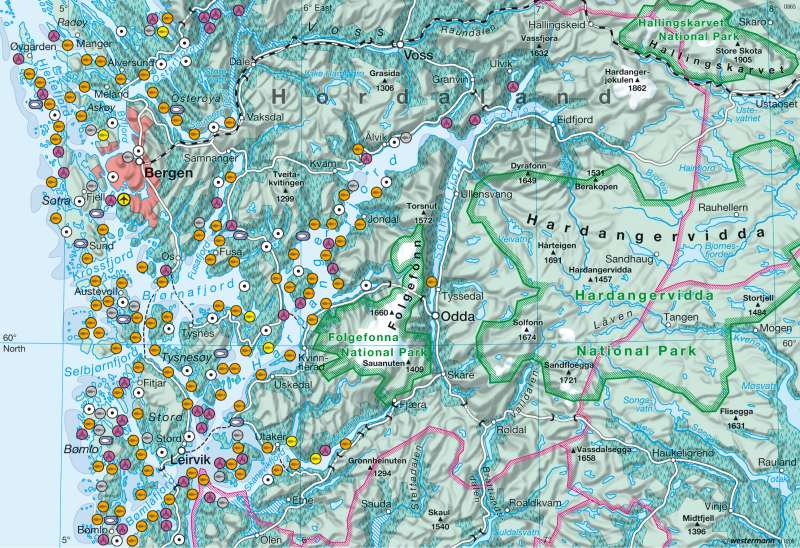Hordaland (Norway) — Aquaculture in the fjords
Northern Europe - Resources
978-3-14-100790-9 | Page 62 | Ill. 1

Information
In global comparison, European countries do not play a leading role as fishing nations, with one exception — Norway. In 2006 the Scandinavian country was in eleventh position worldwide in terms of both catches and the production of fish and seafood, while Europe's number two — Iceland — occupied 18th position. This figure includes both catches and aquaculture.China was in undisputed first place with a total of 51.5 million tons, about two-thirds of which, or 34.4 million tons, came from fish farms. China's dominant position is shown by the figures for the country in second place: Peru produced some 7 million tons, only 28,000 tons of which was from aquaculture.
Out of Norway's total production of some three million tons, 709,000 tons came from aquaculture. Taking into account fish farming alone, Norway was in as high as ninth place worldwide, an enormous achievement when set against countries like China, India, Indonesia, the USA, Japan and Russia in the top positions.
Norway advances even further when its fish industry is viewed from the export perspective. Here it takes second place between China and Thailand, and in 2006 it earned more than five billion US dollars from the export of seafood. The share of aquaculture in export earnings has increased continuously.
Situation in the Province of Hordaland
Hordaland is Norway's most important province for aquaculture. In 2005 nearly one-fifth of all salmon and trout from Norway were farmed there, i.e. some 102,000 tons of salmon and 20,000 tons of trout In 158 fish farms. 80 percent of these quantities were exported, mainly to Russia, Denmark, France and Japan. Hordaland thus generates around one-tenth of Norwegian fish export earnings. This success has brought new ideas. Thus the farming of other species of seafood is being attempted, including shellfish, mussels, cod and halibut.
The map shows the dense stock of fish farms in Hordaland, the majority of which specialize in salmon. From breeding tanks the juvenile fish are distributed among a large number of tanks where they can mature for up to two years. Particularly suitable animals are selected for breeding purposes and transferred to tanks specially earmarked for the purpose. As soon as the fish have attained a sufficient size for consumption, they are slaughtered and processed in abattoirs.
The intensive animal husbandry damages the environment: water quality deteriorates and the natural habitat is reduced for fish living in the wild. Norway responded to this in 2003 and 2007 by designating a total of 52 national salmon rivers and 29 national salmon fjords, in which the most important salmon stocks were to be allowed to regenerate without interference from man. In these areas it is forbidden to farm any fish that migrate from salt water to fresh water to spawn — the salmon being the best known of these. Existing farms in the protected areas must be closed by March 2011. Such a fjord can be identified on the map to the north-east of Bergen.
D. Falk; Ü: J. Attfield




